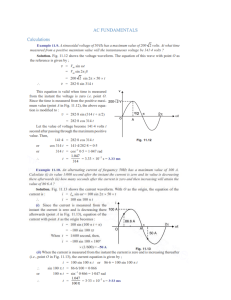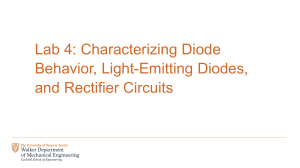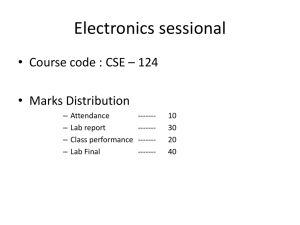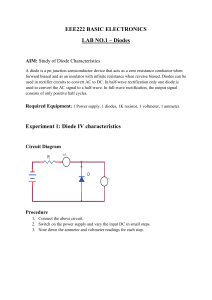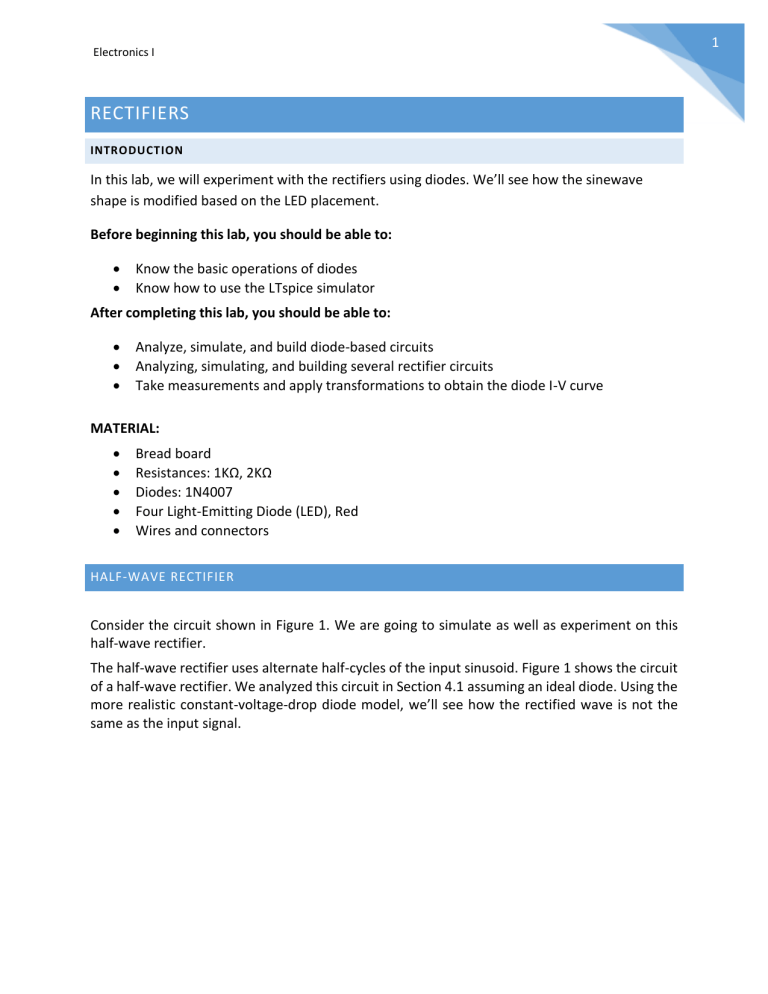
Electronics I RECTIFIERS INTRODUCTION In this lab, we will experiment with the rectifiers using diodes. We’ll see how the sinewave shape is modified based on the LED placement. Before beginning this lab, you should be able to: • • Know the basic operations of diodes Know how to use the LTspice simulator After completing this lab, you should be able to: • • • Analyze, simulate, and build diode-based circuits Analyzing, simulating, and building several rectifier circuits Take measurements and apply transformations to obtain the diode I-V curve MATERIAL: • • • • • Bread board Resistances: 1KΩ, 2KΩ Diodes: 1N4007 Four Light-Emitting Diode (LED), Red Wires and connectors HALF-WAVE RECTIFIER Consider the circuit shown in Figure 1. We are going to simulate as well as experiment on this half-wave rectifier. The half-wave rectifier uses alternate half-cycles of the input sinusoid. Figure 1 shows the circuit of a half-wave rectifier. We analyzed this circuit in Section 4.1 assuming an ideal diode. Using the more realistic constant-voltage-drop diode model, we’ll see how the rectified wave is not the same as the input signal. 1 2 Electronics I Figure 1: Circuit used for half-wave rectifier Pre-lab - Simulation • Assume resistance is equal to 1KΩ. • Create the schematic in LTspice. You can use the given spice model of the 1N4007 provided at the end of this document. You need to import this model to the schematic and use it. • Simulate the circuit by varying VS from - 3 V to +3 V in increments of 0.1 V, and generate a plot of iD vs. VS and another graph VO vs. VS. • Do you see a resemblance between the two graphs? If yes, what is the reason? NOTE: Include your graphs in your pre-lab. In your prelab report, include all your calculations, and analysis steps, a clear screenshot of the LTspcie schematic, and answers to all of the questions. LAB PROCEDURE • • • • • • • Measure the resistor value using a digital multimeter. Assemble the circuit onto a breadboard, using the 1N4007 diode. o Make sure to follow the breadboard preparation steps as described in lab one. Vary the input voltage from - 3 V to +3 V in increments of 0.5 V. For each point, measure the output voltage using a digital multimeter, and report the current consumption. Now set up the signal generator to have a sinewave with 3V peak amplitude, 100Hz frequency, and zero offset. Use this as your input signal. Capture the output waveform, and make sure to read the peak value of the rectified output voltage. Find out at what point in the input waveform, the rectified waveform becomes positive i.e. something other than zero? What happens if the direction of the diode is reversed? Repeat the experiment for input sinewave with the direction of the diode reversed. 3 Electronics I Demonstration: Demonstrate the operation of your circuit to the Teaching Assistant. Have the GA initial their lab checkbook. FULL-WAVE RECTIFIER Rectifiers convert AC voltages into unipolar voltages. Half-wave rectifiers do this by passing the voltage in half of each cycle and blocking the opposite-polarity voltage in the other half of the cycle. Full-wave rectifiers accomplish the task by passing the voltage in half of each cycle and inverting the voltage in the other half cycle. The purpose of this activity is to investigate the use of four diodes as a bridge rectifier. Four diodes can be arranged in a bridge configuration to provide a full-wave rectification from a single AC phase as shown here. However, it can also be seen that only the AC input or the load can be referenced to ground. Figure 2. Circuit schematic Pre-lab - Simulation • • • • Using a resistance of 2kΩ, create the circuit schematic of the circuit given above in the LTspice simulation environment. Use the spice model of diode 1N4007. You need to export the model into your schematic. Apply a sinewave input with 5V amplitude and 5 Hz frequency. Use the LTspice probe and math function to show the potential difference across resistance RL. Electronics I LAB PROCEDURE • • • • • • • Measure the resistance value using the digital multimeter. Construct the circuit given in Figure 2 using LEDs. The waveform generator should be configured for a 5 Hz Sine wave with 5-volt amplitude and 0-volt offset. Capture a screenshot of both the input voltage and voltage across the resistor. Are two LEDs ever both ON at the same time? If so, which two? Record the value of the peak voltage of resistor RL. Increase the input frequency. At what frequency do the flashing LEDs stop flickering and begin to appear at a constant intensity? Demonstration: Demonstrate the operation of your circuit to the Teaching Assistant. Have the GA initial their lab checkbook. CLEAN UP Now that the lab is complete, please clean up your work area. You can save the wires you made and take them with you for your next lab. Please note that the GA will inspect your work area afterward. There is a penalty mark for not cleaning the work area. POST-LAB ANALYSIS These steps are related to the half-wave rectifier with one diode. Make sure to answer these questions in your lab report. • • • • • Generate a plot of iD vs. VS and a plot of VO vs. VS, using your measurement data. Since iD = VO / R, do the two plots generally agree? Since the diode voltage is VD = VS – VO, a new plot of iD vs. (VS – VO). Is it what you expect? For the case of input signal equal to the sinewave, why is the peak value of the rectified output less than the peak value of the AC input and by how much? Now consider the full wave rectifier and explain the disadvantages of this circuit regarding voltage drop across the resistor. Explain. 4 Electronics I * DIODES INCORPORATED AND ITS AFFILIATED COMPANIES AND SUBSIDIARIES (COLLECTIVELY, "DIODES") * PROVIDE THESE SPICE MODELS AND DATA (COLLECTIVELY, THE "SM DATA") "AS IS" AND WITHOUT ANY * REPRESENTATIONS OR WARRANTIES, EXPRESS OR IMPLIED, INCLUDING ANY WARRANTY OF MERCHANTABILITY * OR FITNESS FOR A PARTICULAR PURPOSE, ANY WARRANTY ARISING FROM COURSE OF DEALING OR COURSE OF * PERFORMANCE, OR ANY WARRANTY THAT ACCESS TO OR OPERATION OF THE SM DATA WILL BE UNINTERRUPTED, * OR THAT THE SM DATA OR ANY SIMULATION USING THE SM DATA WILL BE ERROR FREE. TO THE MAXIMUM * EXTENT PERMITTED BY LAW, IN NO EVENT WILL DIODES BE LIABLE FOR ANY DIRECT OR INDIRECT, * SPECIAL, INCIDENTAL, PUNITIVE OR CONSEQUENTIAL DAMAGES ARISING OUT OF OR IN CONNECTION WITH * THE PRODUCTION OR USE OF SM DATA, HOWEVER CAUSED AND UNDER WHATEVER CAUSE OF ACTION OR THEORY * OF LIABILITY BROUGHT (INCLUDING, WITHOUT LIMITATION, UNDER ANY CONTRACT, NEGLIGENCE OR OTHER * TORT THEORY OF LIABILITY), EVEN IF DIODES HAS BEEN ADVISED OF THE POSSIBILITY OF SUCH DAMAGES, * AND DIODES' TOTAL LIABILITY (WHETHER IN CONTRACT, TORT OR OTHERWISE) WITH REGARD TO THE SM * DATA WILL NOT, IN THE AGGREGATE, EXCEED ANY SUMS PAID BY YOU TO DIODES FOR THE SM DATA. *SRC=1N4007;DI_1N4007;Diodes;Si; 1.00kV 1.00A 3.00us Diodes, Inc. diode .MODEL DI_1N4007 D ( IS=76.9p RS=42.0m BV=1.00k IBV=5.00u + CJO=26.5p M=0.333 N=1.45 TT=4.32u ) 5


